This Environmental Health & Safety guideline documentation is intended for researchers and laboratory personnel.
The Basics
What is Hazardous Waste?
Hazardous waste is unwanted or discarded hazardous materials that may harm the health or well-being of people or the environment. The basic waste types are:
Whenever possible keep these types of waste separate from each other. Disposal of mixtures of these is difficult and expensive. Also, to help minimize hazardous waste generation—be sure to keep your hazardous wastes separated from normal non-hazardous wastes as much as possible.
What is chemical waste?
Chemical waste is any waste that is toxic, corrosive, ignitable or otherwise listed by the Environmental Protection Agency (EPA). This includes laboratory chemicals, cleaning products, paint, copier toner, batteries, fluorescent bulbs, electronic devices, photographic and shop chemicals. If you are unsure whether the waste you generate is hazardous, please contact EH&S.
Certain expired and unusable chemicals are hazardous waste and subject to regulations. Watch for expiration dates on containers of peroxide-forming chemicals including ethers.
What about radioactive waste?
If your waste has a radioactive component, please contact Radiation Safety for assistance and required training. Radioactive waste is managed under different procedures from those described in this document, see page 21.
What is biohazardous waste?
Biohazardous waste is biological, infectious, and some non-infectious waste. Biological waste includes cultures, plates, media, and other materials that contain or come in contact with living cells, body fluids, viruses, clinical materials, and other microorganisms. Infectious waste is biological waste that involves the presence of organisms containing recombinant DNA or other organisms hazardous to human health. Non-infectious waste includes all examples listed under biological waste that do not meet the criteria of infectious, or have been rendered non-infectious by chemical disinfection or autoclaving.
If your material/waste has a biohazardous component, please contact the Biosafety unit.
Why do I need to know this information?
Anyone who handles or manages hazardous waste is considered a hazardous waste generator and is subject to the Federal and State Hazardous Waste regulations that are briefly described in this booklet. Important topics for hazardous waste generators include:
Failure to properly manage Hazardous Wastes in your area of responsibility could result in fines and/or penalties which would be incurred by your department.
Hazardous Waste Generators’ Responsibilities
Pollution Prevention & Waste Minimization
Regulations require that, whenever possible, hazardous materials users reduce the amount of waste they generate. Some ways to do this are:
We are also required to handle hazardous materials in a manner that prevents releases to the environment. It is critical that no hazardous materials are poured down drains or thrown in the domestic trash. All chemicals should be stored with some means of containment, to prevent release of spills.
How EH&S Manages Waste
 CU Boulders’s Environmental Health & Safety Department (EH&S) operates an EPA-permitted waste Treatment Storage and Disposal Facility (TSDF). This facility allows EH&S to store waste collected from campus for up to one year before the waste is sent off site for disposal. When Hazardous Material/Waste (HMW) tags are submitted they are evaluated and classified based on compatibility, transportation regulations, and hazardous waste disposal requirements.
CU Boulders’s Environmental Health & Safety Department (EH&S) operates an EPA-permitted waste Treatment Storage and Disposal Facility (TSDF). This facility allows EH&S to store waste collected from campus for up to one year before the waste is sent off site for disposal. When Hazardous Material/Waste (HMW) tags are submitted they are evaluated and classified based on compatibility, transportation regulations, and hazardous waste disposal requirements.
The waste you generate will either be mixed with similar chemicals or packaged in the original containers together with other waste. This is why it is important for EH&S to know exactly what is in your waste, so that safe, compliant disposal can be accomplished efficiently. Waste will also be evaluated for treatability and if possible, the hazards of the waste will be removed.
To help us avoid accidents and citations, please fill out all information on the HMW tag. If you have any questions or need assistance please give us a call at 303-492-7845.
How to Manage Hazardous Waste in Your Lab
 All waste must be stored in a Satellite Accumulation Area (SAA).
All waste must be stored in a Satellite Accumulation Area (SAA).
SAA’s should be…
 The Hazardous Material/Waste Tag (HMW)
The Hazardous Material/Waste Tag (HMW)
Chemical Waste
Chemical waste should be collected and separated into the following categories. Be sure to minimize your hazardous waste by keeping non-hazardous components separate wherever possible. If you have more specific questions about waste segregation, please don’t hesitate to give us a call at (303) 492-7845.
Aerosol Cans
Can be disposed by EH&S using the HMW tag system. Empty aerosols can be recycled through CU Recycling.
Batteries
Deposit in battery collection containers around campus (see EH&S website for locations), or store, and dispose of them via the EH&S Haz Waste Program using the HMW tag. All small sealed batteries are accepted in the collection containers. EH&S recycles all battery types. For large and/or unsealed batteries, use the HMW tag for disposal. If possible, please help us by covering battery terminals with tape to avoid potential short circuits.
Sharps (needles, scalpels, and blades)
Must be rendered non-infectious and separated into approved puncture-proof containers (plastic containers designed for sharps, or alternatively glass or metal containers only) for disposal using the HMW tag. All metal sharps must be disposed through EH&S whether contaminated with hazardous materials or not (e.g. clean).
Broken Glass, Plastic Pipettes Tips, Other Possible Puncture Hazards
Must be rendered non-infectious and separated into puncture-resistant containers (e.g., cardboard, plastic containers, etc.) for disposal via the HMW tag if contaminated or for direct trash disposal if non-contaminated.
Corrosives
Separate acids and bases, and record pH and concentration/volume percentages on the HMW tag. EH&S will neutralize and treat certain aqueous acid and base wastes—please help us by keeping your acid and base waste streams free of organics and metals whenever possible.
Cyanides, Sufides & Isocyanates
Separate from other materials and never store with acids.
Electronic Devices
Must not be thrown out with the regular trash! Most electronic devices contain heavy metals such as lead, silver, and chromium and are regulated waste. Facilities Management—Property Services has a program to recycle or resell all electronic devices from University operations. Please call Property Services at 303-492-6524 for disposal of electronic equipment including CRT’s (computer monitors), circuit boards, hard drives and other electronic devices or parts, regardless of their condition.
Empty Container
If contaminated with acutely hazardous material (EPA “P Listed” waste or if the oral LD50 is less than 50mg/kg) fill out HMW Tag and submit for disposal. The EPA “P List” can be seen on the EH&S website; examples include sodium cyanide, potassium cyanide, osmium tetroxide, sodium azide, etc. If containers are not contaminated with acutely hazardous material, radioactive material, or biologically infectious material: empty containers can be thrown away with regular trash. Obliterate the labels and mark “empty”. Place glass directly into dumpster or in a glass receptacle—Do not place glass in lab or office trash cans. Empty chemical containers and other lab glassware cannot be recycled–they must be thrown away.
Extreme Hazards
Explosive, unstable, highly reactive, or extremely toxic materials may require special disposal. Examples include dry picric acid, arsine, silane, bromine, and acrolein. Contact EH&S before purchasing any extremely hazardous compounds.
Flammables/Solvents
Separate halogenated from non-halogenated solvents and water wherever possible.
Fluorescent Bulbs/Compact Fluorescent Lamps (CFLS)
Contain mercury and are a regulated waste. Bulbs/Lamps generated from University operations can be picked up by EH&S using the HMW tag. Please package the bulbs in their original packing or other protective container to prevent breakage.
Mercury
Separate elemental mercury and mercury compounds from other materials. Disposal of all forms of mercury is extremely costly. As a pollution prevention and safety measure, CU Boulder encourages the use of non-mercury thermometers and other measuring devices. Check with EH&S regarding a free exchange for non-mercury thermometers.
Metals
Must be kept separate from other materials whenever possible, e.g. Antimony, Arsenic, Barium, Beryllium, Cadmium, Chromium, Copper, Lead, Mercury, Molybdenum, Nickel, Selenium, Silver, Thallium, Zinc.
Oxidizers
Keep separate from organics, flammables, and combustibles. Examples include nitrates, oxides, peroxides, permanganates, perchlorates, bromates, bromine, chromates, chlorites, etc.
Paints
Oil based paints/stains and latex paints can be picked up by EH&S using the HMW tag. Please separate latex paints from oil based paints.
Peroxide Formers
Ethers and other peroxide-forming compounds must be inhibited and certified as such. Do not open containers which may have formed explosive peroxide crystals or may have become unstable! Contact EH&S for special handling, inhibiting, and disposal information; a list of peroxide formers can also be found on the EH&S website.
Photographic Wastes
Fixer should be separated from developer. This waste will be treated and discharged to the city’s water treatment plant by EH&S—please help us by keeping your photographic wastes separate from other waste streams.
Pressurized Gas Cylinders
Disposal of gas cylinders is extremely expensive! Please order only what you absolutely cannot do without. Order your gases in “rental” cylinders that can be returned vs. lecture bottles that need to be disposed of. Be aware that your department may be responsible for the cost of cylinder disposal. The EH&S hazardous waste facility is not permitted to store cylinders. They should be stored in a manner that limits access to unauthorized personnel and prevents them from falling. If you have cylinders to dispose of, contact the Hazardous Materials & Waste Management unit.
Solids (debris including gloves, paper, agarose gels, etc.)
Should be kept separate from liquid waste.
Toxins
Keep neurotoxins and other extremely dangerous materials separate. Also keep stock reagents in a secure area.
Chemical Inventories
To comply with Department of Homeland Security regulations and assist with emergency response on campus, EH&S requires all labs and shops to maintain a chemical inventory. The inventory must include the chemical name, container size, storage location, and expiration date if applicable. Chemical inventory is currently submitted to the Chemical Safety unit of EH&S. Chemical management system is done through Bioraft. “Chemtracker” is located on the left side of the homepage and every lab has the ability to view their lab’s inventory.
General Lab Safety
Personal Protective Equipment (PPE)
Personal protective equipment should be provided by your supervisor and be appropriate for the type of work you do. Common types of PPE include:
Safety glasses, closed-toe shoes, and long pants should be worn in all laboratories on campus. Lab coats are recommended as well—especially when working with flammable or highly reactive substances. You must verify the proper level of protection recommended for each process you do to ensure your personal safety.
Material Safety Data Sheets (MSDS)
MSDS’s have information provided by chemical manufacturers, including hazard information, type of PPE required, possible reactions and storage precautions. An alphabetized binder of MSDS’s for your lab should be visible and readily available. If you are missing an MSDS for a particular chemical, you may contact the manufacturer or look online.
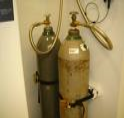 Gas Cylinders
Gas Cylinders
Gas cylinders larger than lecture size should always be securely strapped (around the body of the cylinder, not the neck) to a lab bench or wall. Gas cylinders should never lie on their side nor be rolled. Special precautions should be taken to separate flammables from oxidizers (generally 20 ft. apart).
Safety Showers/Eyewashes
Safety showers and eyewashes can save your life or your sight. You must familiarize yourself with the equipment in your work area. Eyewashes should be flushed weekly to avoid sediment buildup that could damage your eyes. Ensure safety showers and eyewashes are easily accessible and not blocked by lab equipment. Safety showers are tested by EH&S periodically, and should only be activated by lab personnel in true emergencies.
General Hygiene
No eating or drinking is permitted in laboratory spaces. Although some labs have desks close to research spaces, care must be taken to keep your desk area clean and chemical free. Remove gloves and lab coats when leaving hazardous work areas to prevent contamination.
Refrigerators
No flammable materials are allowed in regular, household refrigerators. If you need to refrigerate flammables, they must be in a flammable rated refrigerator, designed to prevent vapor ignition.
Spill Kits/Spill Clean-Up Materials
Lab personnel should keep materials on-hand and readily available to clean up small, incidental chemical spills, such as paper towels, absorbent pads or pillows, mercury spill kits, drain plugs/covers, dust pan, tongs to pickup broken glass, etc. Don’t allow chemicals to go down drains—stop materials from releasing to drains during a spill if you can safely do so. Clean-up supplies are available commercially or contact EH&S for assistance with creating a spill kit. All materials generated and collected during clean-up of a small chemical spill should be put in a sealed container or plastic bag and disposed of through EH&S using a HMW tag. Always wear proper PPE during these activities, and never clean-up a spill unless you have the proper experience, equipment, and materials to do it, and can avoid injuries to yourself and others. For large spills, fires, or incidents involving life/safety contact CUPD (Emergency: 911, Non-Emergency: 303-492-6666)
 Chemical Safety
Chemical Safety
- Store flammables, oxidizers, acids, and bases all separate from each other. Flammables should be in flammable cabinets. All liquids should be in secondary containment. Incompatible chemicals should never be stored together.
- Follow standard procedures for chemical use in your work area. Deviations from standard protocols have caused serious accidents.
- All containers must be labeled with full, english names. No abbreviations, symbols, or formulas are permitted. Empty containers must have labels crossed out and be labeled “empty”. Even water must be labeled.
- “Unknowns” or unidentified containers occasionally turn up in labs, and cause huge problems for personnel who have to determine what substances are involved. It is important to label your chemicals and waste at all times. Call EH&S if you have found a suspicious container (bulging, crusty, unlabeled, etc.).
- Hydrofluoric Acid, Perchloric Acid, and Trifluoroacetic Acid use requires additional precautions. These are extremely dangerous chemicals that are commonly used on campus. If you will be using these materials, ensure you are fully trained by your supervisor and have researched the material’s hazards.
- Mercaptan use must be done in a hood! Opening mercaptans without proper ventilation causes false fire-alarms due to the gas like odor.
Basic Emergency Response
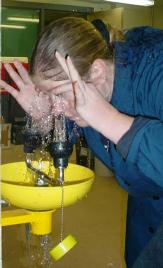 Here are some basic Emergency Actions for your reference. If in doubt, evacuate and call 911. Never perform any actions you feel unsafe or uncomfortable doing. Always notify EH&S and your supervisor for all emergencies.
Here are some basic Emergency Actions for your reference. If in doubt, evacuate and call 911. Never perform any actions you feel unsafe or uncomfortable doing. Always notify EH&S and your supervisor for all emergencies.
Gas Smell
This is common, especially with many labs on campus using mercaptans. If you smell gas, pull fire alarm and evacuate immediately. Do not use light switches or phones, or anything that causes sparking within the building.
Large Spills or Fires
Eyewash & Safety Shower Use
***Note: It is always wise to grab your MSDS binder for your work area when there is any incident involving chemicals. Emergency Personnel will request this information.
Biohazardous Waste
Determine if your waste is infectious. Render all infectious waste non-infectious by using effective chemical disinfection methods or by autoclaving. If in doubt, be conservative and autoclave or chemically treat all non-radioactive biological waste. Do not use an autoclave if your waste contains radioactive material. If you have questions, contact the Biosafety unit.
Autoclaves
Infectious waste must be autoclaved in an EH&S certified autoclave. These autoclaves have a sticker on the front signifying an “EH&S Autoclave #”.
 All certified autoclaves must be spore tested every 90 days and have a Vendor perform maintenance every 6 months according to the campus Biological Laboratory Waste Management Disposal Policy and Procedure—which can be found on the EH&S website. Contact EH&S to add an autoclave to the program or if you have questions regarding this policy and procedure.
All certified autoclaves must be spore tested every 90 days and have a Vendor perform maintenance every 6 months according to the campus Biological Laboratory Waste Management Disposal Policy and Procedure—which can be found on the EH&S website. Contact EH&S to add an autoclave to the program or if you have questions regarding this policy and procedure.
Non-Biohazardous Waste Tags
These tags are available from EH&S, and need to be filled out completely and attached to each autoclave bag. Bags without a completed and signed tag attached will be considered infectious and will not be picked up for disposal.
This waste will be going to a landfill, therefore it is very important that the waste is non-infectious and no chemical or radioactive contaminants are included.
Biological Waste
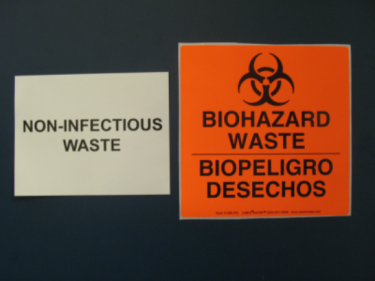 Any container or trash can used in the lab to store the waste prior to autoclaving or putting the bag into a designated “Certified Non-biohazardous Materials” receptacle must be properly labeled to indicate whether it is “Non-Infectious Waste” or “Biohazardous Waste”. These labels can be obtained from EH&S by calling (303) 492-6025.
Any container or trash can used in the lab to store the waste prior to autoclaving or putting the bag into a designated “Certified Non-biohazardous Materials” receptacle must be properly labeled to indicate whether it is “Non-Infectious Waste” or “Biohazardous Waste”. These labels can be obtained from EH&S by calling (303) 492-6025.
Whether it is a waste that is just biologically appearing but non-infectious or a waste that was disinfected—it must be sealed in an autoclave bag. A Non-biohazardous waste tag must be filled out, and the correct box needs to be checked accordingly to what kind of waste it is.
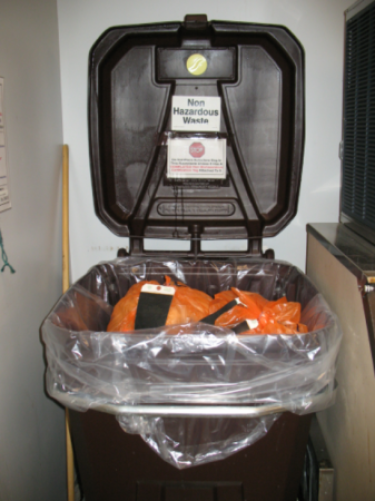 Attach the tag to the bag, and put the top white copy into the designated pocket. Put the bag into a designated “Certified Non-biohazardous Materials” receptacle.
Attach the tag to the bag, and put the top white copy into the designated pocket. Put the bag into a designated “Certified Non-biohazardous Materials” receptacle.
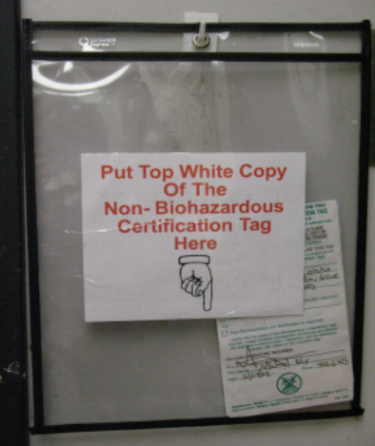 Autoclave bags must have a sterilization indicator built into the bag or have a piece of autoclave tape attached to the bag or container for the waste to be picked up—the only exception to this rule is for disposal of wastes that are biologically appearing but non-infectious and do not need to be autoclaved for disposal.
Autoclave bags must have a sterilization indicator built into the bag or have a piece of autoclave tape attached to the bag or container for the waste to be picked up—the only exception to this rule is for disposal of wastes that are biologically appearing but non-infectious and do not need to be autoclaved for disposal.
Some non-infectious liquid waste may be drain-disposed if it contains no other regulated chemicals or radioactive materials. Contact EH&S before drain disposing any waste.
Some animal parts and carcasses that are non-infectious, non-radioactive and do not contain any chemical contamination may be disposed of through the EH&S Biowaste program—for approval call EH&S at 303-492-6025.
Sharps
All radioactive sharps must go to Radiation safety for disposal.
Sharps (needles, syringes, blades, scalpels) cannot be disposed of with a Non-Biohazardous Waste Tag; they must be disposed of with a HMW Tag.
Sharps cannot be trash disposed, even if clean. They must be placed in puncture-proof, sealed containers (no plastic or autoclave bags) and tagged for hazardous material/waste pickup.
Due to their biomedical appearing nature, syringe bodies must also be HMW tagged for EH&S pick-up (although it is not necessary to put these into puncture-proof containers).
Infectious sharps must be autoclaved. Chemical disinfection is not effective for needles and small syringes; these must be autoclaved in a puncture-proof container with a built in sterilization indicator, or have autoclave tape on the container. Be sure that the container is not completely sealed during autoclaving so that the sharps won’t puncture it due to the heat and pressure.
Even sharps that have been used to administer chemicals, or draw fluids from “clean” animals must be autoclaved. This is for protection of personnel handling the waste.
Write in the word “Autoclaved” under the chemical constituents section of the HMW Tag if the sharps were autoclaved. Autoclaved sharps containers must also have a sterilization indicator included.
Sharps Segregation Requirements
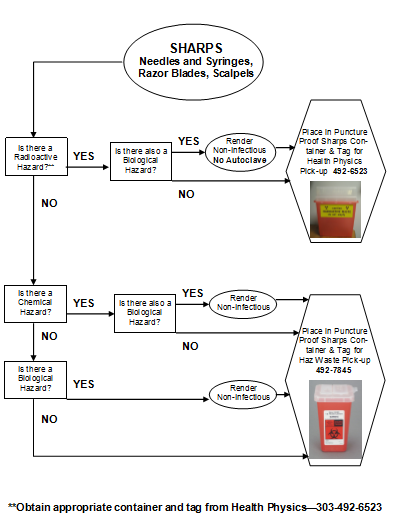
Radioactive Waste
Radioactive waste is managed under different procedures from those described in this booklet. Please contact the Radiation Safety unit for information regarding radioactive material/waste. Radiation training is a separate training from the hazardous waste training, and is required if you are working with radioactive materials.
